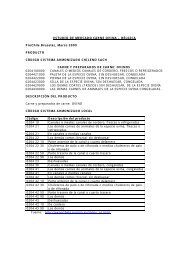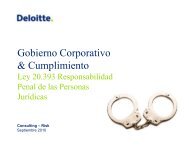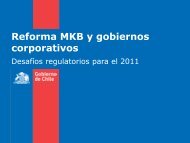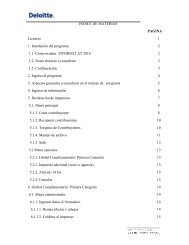Citizen Centric Service is a - Deloitte Chile
Citizen Centric Service is a - Deloitte Chile
Citizen Centric Service is a - Deloitte Chile
Create successful ePaper yourself
Turn your PDF publications into a flip-book with our unique Google optimized e-Paper software.
<strong>Citizen</strong> <strong>Centric</strong> <strong>Service</strong><br />
Changing the way<br />
government g does<br />
business<br />
Santiago, <strong>Chile</strong><br />
July 7, 2011<br />
© <strong>Deloitte</strong> & Touche LLP and affiliated entities.
Objectives today<br />
• Review global trends in citizen service<br />
• Identify key capabilities that governments are building<br />
• D<strong>is</strong>cuss lessons learned in citizen centric transformations<br />
• Consider implications for the public sector in <strong>Chile</strong><br />
1 <strong>Citizen</strong> <strong>Centric</strong> <strong>Service</strong> – Changing the way government does business<br />
© <strong>Deloitte</strong> & Touche LLP and affiliated entities.
Key messages to take away<br />
• Governments around the world are facing challenging times<br />
• Growing f<strong>is</strong>cal pressures and increasing stakeholder<br />
expectations t ti for f service i are leading l di many governments t tto<br />
launch citizen focused transformations, including;<br />
– more efficient service delivery through multi-channel capabilities<br />
– more effective service bundles that meet customer needs<br />
– more motivated staff with the right training, tools, and rewarding roles<br />
– more collaboration across Min<strong>is</strong>tries in order to deliver integrated services<br />
– movement away from operational roles to stewardship roles<br />
• Empowered and informed citizens, increasingly used to greater transparency<br />
and interaction, are forcing governments to rethink how they operate, how<br />
they deliver services, and how they collaborate with their stakeholders.<br />
2<br />
The most innovative citizen centric governments are building services inspired<br />
by both Banks and Hotels<br />
<strong>Citizen</strong> <strong>Centric</strong> <strong>Service</strong> – Changing the way government does business<br />
© <strong>Deloitte</strong> & Touche LLP and affiliated entities.
<strong>Citizen</strong> <strong>Centric</strong> <strong>Service</strong><br />
Definition<br />
V<strong>is</strong>ion and M<strong>is</strong>sion<br />
<strong>Service</strong> Principles<br />
3 <strong>Citizen</strong> <strong>Centric</strong> <strong>Service</strong> – Changing the way government does business<br />
© <strong>Deloitte</strong> & Touche LLP and affiliated entities.
What <strong>is</strong> <strong>Citizen</strong> <strong>Centric</strong> <strong>Service</strong>?<br />
“<strong>Citizen</strong>-Centred <strong>Service</strong> considers citizens’ needs at every stage of the<br />
service design and delivery process; that <strong>is</strong>, citizens’ needs become the<br />
organizing principle around which the public interest <strong>is</strong> determined and<br />
service i delivery d li <strong>is</strong> i planned.” l d ”<br />
• Provides integrated public-facing information and service delivery<br />
• Enhances the customer experience p by y bundling g information and selected services<br />
across government entities, based on a clear understanding of segmented customer<br />
needs and life events<br />
• Designs service delivery channels that deliver<br />
information information, transactions, transactions and even case management<br />
in a “one stop shop” approach<br />
• Improves customer experience and operating efficiencies<br />
by simplifying, automating, and optimizing front-end service<br />
delivery processes<br />
• Leads government service delivery efficiency by eliminating<br />
asset duplication and redundancy within the government<br />
• Often requires new degrees of cross Min<strong>is</strong>try collaboration<br />
and governance<br />
4<br />
<strong>Citizen</strong> <strong>Centric</strong> <strong>Service</strong> – Changing the way government does business<br />
© <strong>Deloitte</strong> & Touche LLP and affiliated entities.
4<br />
<strong>Citizen</strong> <strong>Centric</strong> <strong>Service</strong> <strong>is</strong> a “One Stop Shop” for all your<br />
information and transaction needs from Government<br />
Multi-Channel Access<br />
Min<strong>is</strong>try<br />
3<br />
<strong>Service</strong> information, application and<br />
delivery are enabled through<br />
multiple channels. These could<br />
include Walk-in Centres, Online,<br />
Min<strong>is</strong>try<br />
2<br />
Contact Centre, Mobile/SMS,<br />
Kiosks, Drive-Thru<br />
Min<strong>is</strong>try<br />
1<br />
<strong>Service</strong><br />
<strong>Service</strong><br />
2<br />
1<br />
5<br />
Integrated<br />
Government<br />
<strong>Service</strong><br />
3<br />
<strong>Service</strong> 3 UAE<br />
Government entities work in<br />
collaboration to provide integrated<br />
services across multiple p min<strong>is</strong>tries, ,<br />
reduce duplication, and drive<br />
efficiencies across the whole of<br />
government . General information<br />
1<br />
and transactions handles by one<br />
Customer <strong>Centric</strong> Design<br />
service entity, and complex cases<br />
are handled by Min<strong>is</strong>try<br />
Customers are categorized g in segments g<br />
that have different needs and expectations<br />
in term of information, service standards<br />
and offerings. Examples could be ethnicity,<br />
citizen status, special needs<br />
5 <strong>Citizen</strong> <strong>Centric</strong> <strong>Service</strong> – Changing the way government does business<br />
“One Stop Shopping”<br />
Getting information and applying for<br />
services <strong>is</strong> done in one place p without<br />
having to v<strong>is</strong>it multiple locations,<br />
websites or calling different toll free<br />
numbers<br />
2<br />
“Bundled” Bundled Offerings<br />
Customers needs are reflected in<br />
life event bundles. These bundles<br />
group related services from multiple<br />
entities, and are mutually exclusive<br />
in terms of services required<br />
© <strong>Deloitte</strong> & Touche LLP and affiliated entities.
Leading governments around the world are all focusing<br />
on <strong>Citizen</strong> service<br />
6<br />
M<strong>is</strong>sion V<strong>is</strong>ion<br />
UNITED ARAB<br />
EMIRATES<br />
MINISTRY OF<br />
CABINET AFFAIRS<br />
• To provide secure secure,<br />
• To achieve better outcomes for Canadians through<br />
knowledgeable, one-stop,<br />
service excellence<br />
personalized service to<br />
Canadians<br />
• Serving Australia by ass<strong>is</strong>ting<br />
people to become self-sufficient<br />
and supporting those in need<br />
• Our job <strong>is</strong> to make things easier<br />
for you<br />
• Bringing g g ggovernment to yyou<br />
Efficiency and Effectiveness are the Objectives<br />
<strong>Citizen</strong> <strong>Centric</strong> <strong>Service</strong> – Changing the way government does business<br />
• Help meet citizens citizens’ expectations for improved<br />
service and, in particular, to improve the<br />
management of social security and employment<br />
services<br />
• To be recognized for meeting or exceeding<br />
customer expectations with our service, solutions,<br />
leadership and people…EVERY TIME<br />
• Be one of the leading g nations in the world by y 2021, ,<br />
• putting ‘citizens first’ to promote a lean, forward<br />
looking, accountable and innovative government<br />
© <strong>Deloitte</strong> & Touche LLP and affiliated entities.
Examples of guiding principles for <strong>Citizen</strong> <strong>Centric</strong><br />
<strong>Service</strong><br />
7<br />
One Stop Shop: Join up multiple government entities in a “one stop<br />
shop” environment<br />
Customer <strong>Centric</strong>ity: Customer-centric Customer centric approach though a clear<br />
understanding of service needs<br />
Integration Focus: Coordinate with all other service-related initiatives<br />
in national or jur<strong>is</strong>diction, as required<br />
Peer Leadership: Achieve world-class customer service and<br />
establ<strong>is</strong>h service standards for service delivery<br />
Self <strong>Service</strong>: Offer self-service channel options to improve efficiency<br />
and reduce cost-to-serve<br />
Multi Channel: Offer seamless and coordinated services across<br />
multiple channels<br />
<strong>Service</strong> Delivery: Support min<strong>is</strong>tries through service delivery –<br />
min<strong>is</strong>tries will retain service policy and design roles<br />
<strong>Service</strong> Culture: Develop a strong service-oriented culture in the<br />
workplace<br />
Empowerment: Empower and reward its staff to deliver high high-quality quality<br />
service and become an employer of choice<br />
<strong>Citizen</strong> <strong>Centric</strong> <strong>Service</strong> – Changing the way government does business<br />
<strong>Service</strong><br />
Culture<br />
S<strong>Service</strong> i<br />
Delivery<br />
Multi<br />
Channel<br />
Empowerment<br />
Self<br />
<strong>Service</strong><br />
One Stop<br />
Shop<br />
Customer<br />
<strong>Centric</strong>ity<br />
Peer<br />
Leadership<br />
Integration<br />
Focus<br />
© <strong>Deloitte</strong> & Touche LLP and affiliated entities.
Growth of <strong>Citizen</strong><br />
expectations<br />
e pectat o s<br />
Typical service needs<br />
Choice of channels<br />
Future trends<br />
8 <strong>Citizen</strong> <strong>Centric</strong> <strong>Service</strong> – Changing the way government does business<br />
© <strong>Deloitte</strong> & Touche LLP and affiliated entities.
The typical service “journey” for customers<br />
• At the highest level, in most governments, citizens and businesses will<br />
follow the same “journey” to receive essential or required public<br />
services:<br />
9<br />
11. Get <strong>Service</strong><br />
Information<br />
Customer finds out<br />
what kind of service<br />
<strong>is</strong> required, and<br />
how/when to get it<br />
Customer <strong>Service</strong> Journey<br />
22. Applying for<br />
<strong>Service</strong>s<br />
Customer initiates<br />
interaction with<br />
government to<br />
obtain desired<br />
services<br />
33. Receiving<br />
<strong>Service</strong>s<br />
Customer pays for,<br />
and receives receives,<br />
service<br />
5. Special Case Customers<br />
6. Issue Resolution<br />
7. Customer Feedback<br />
<strong>Citizen</strong> <strong>Centric</strong> <strong>Service</strong> – Changing the way government does business<br />
4. Completing p g<br />
the <strong>Service</strong><br />
Interaction<br />
Customer completes<br />
service interaction<br />
(fulfillment)<br />
© <strong>Deloitte</strong> & Touche LLP and affiliated entities.
Leading customer service starts by meeting basic<br />
expectations, p and can include Hotel-like differentiators<br />
Experiennce<br />
Customer C<br />
10<br />
Source: <strong>Service</strong><br />
UAE Concept<br />
Briefing<br />
Document<br />
Leading<br />
<strong>Service</strong><br />
Value-Added<br />
<strong>Service</strong><br />
Differentiators<br />
Basic Expectations for service<br />
<strong>Citizen</strong> <strong>Centric</strong> <strong>Service</strong> – Changing the way government does business<br />
Remember me<br />
Inspire me<br />
Involve Me<br />
Personalization<br />
Customized (e.g. fast track)<br />
Choice of Channels<br />
Proactive<br />
Great Experience<br />
Quality/Accuracy<br />
Timeliness/Efficiency / ff<br />
Ease of Use/Convenience<br />
Privacy<br />
Fairness<br />
Good Value for Money<br />
© <strong>Deloitte</strong> & Touche LLP and affiliated entities.
Typical expectations for government service standards<br />
• 5 to 9 minutes: The maximum time to<br />
wait in any lineup at a government office.<br />
• 2 people: l Th The maximum i number b of f<br />
people you should have to deal with in<br />
order to get service at a government<br />
office.<br />
• 15 minutes: A reasonable amount of<br />
time to spend travelling to a government<br />
office, one way.<br />
• 30 seconds: An acceptable amount of<br />
time to wait on hold on the phone before<br />
you speak to a person.<br />
¹ Slide content taken from <strong>Citizen</strong>-Centred <strong>Service</strong>: Canada’s Journey of Public Sector<br />
Transformation, Presentation to Innovation Value Institute Summer Summit by Guy Gordon,<br />
EExecutive ti Director Di t IInstitute tit t for f <strong>Citizen</strong>-Centred Citi C t dS<strong>Service</strong> i<br />
11<br />
<strong>Citizen</strong> <strong>Centric</strong> <strong>Service</strong> – Changing the way government does business<br />
• 2 people: The maximum number of<br />
people you should have to deal with in<br />
order to get g the service on the<br />
telephone.<br />
• Same day: When you should receive a<br />
reply to a voice mail or email, if you<br />
lleave your voice i mail il or email il at t 10 10:00 00<br />
AM.<br />
• 1 to 2 weeks: The acceptable length of<br />
time to wait from the day you send the<br />
letter until the day you receive<br />
a reply by mail.<br />
© <strong>Deloitte</strong> & Touche LLP and affiliated entities.
“No wrong door”<br />
• <strong>Citizen</strong>s increasingly expect multiple service channels, including emerging technologies<br />
such as mobile channels and social media<br />
• Channels can be:<br />
12<br />
– SSelf-Ass<strong>is</strong>ted: lf A i t d FFully ll automated t t d or requiring i i littl little iinteraction t ti bbetween t customers t and d government. t<br />
Self-ass<strong>is</strong>ted channels have a significantly lower cost to serve than ass<strong>is</strong>ted channels.<br />
– Ass<strong>is</strong>ted: Not automated and requiring a live agent to provide information or transactions. These<br />
channels have a higher cost to serve as a result of requiring overhead and staffing to operate.<br />
Self-Ass<strong>is</strong>ted<br />
• Low touch<br />
• Highly efficient<br />
• Low cost to serve<br />
Ass<strong>is</strong>ted<br />
• High touch<br />
• Can be efficient<br />
• Higher cost to serve 2<br />
Online/<br />
Web<br />
Email Kiosks<br />
SMS/<br />
Mobile<br />
Social<br />
Media<br />
<strong>Service</strong><br />
Center<br />
Phone Mail Fax<br />
“Don’t Don t make me come in unless I have to to. <strong>Citizen</strong>s expect services to be where they need them, them when they need them them. ¹”<br />
¹ Finding from <strong>Service</strong>Ontario case study.<br />
<strong>Citizen</strong> <strong>Centric</strong> <strong>Service</strong> – Changing the way government does business<br />
© <strong>Deloitte</strong> & Touche LLP and affiliated entities.
Self service a “win-win” reality<br />
Self-service <strong>is</strong> a highly beneficial solution for government services that can be effectively<br />
provided through online portals, kiosks, SMS/mobile, or other person-centric vehicles. The<br />
“win-win” reality of self-services <strong>is</strong> reflected in the following benefits:<br />
• More transactions per employee and per customer v<strong>is</strong>it<br />
• Greater efficiency<br />
• RReduces d “ti “time and d cost t to t serve” ”<br />
• Facilitates greater self-service amongst customers<br />
• Fosters preparation and publication of FAQs for self-service<br />
13<br />
Positive results seen in the<br />
following key performance<br />
indicators (KPIs)<br />
Transaction<br />
On-time<br />
Delivery<br />
Agent<br />
Utilization<br />
% Self<br />
<strong>Service</strong><br />
Utilization<br />
Average<br />
Cycle Time<br />
Average<br />
Cost per<br />
Transaction<br />
<br />
“Don’t make me come in unless I have to. <strong>Citizen</strong>s expect services to be where they need them, when they need them.¹”<br />
¹ Finding from Ser <strong>Service</strong>Ontario iceOntario case st study.<br />
d<br />
<strong>Citizen</strong> <strong>Centric</strong> <strong>Service</strong> – Changing the way government does business<br />
© <strong>Deloitte</strong> & Touche LLP and affiliated entities.
“One and done”<br />
Increasing opportunities to integrate programs across min<strong>is</strong>tries and departments<br />
through service bundling, which:<br />
• Aims to complete a transaction in a single session<br />
• Promotes evaluation and prioritization of selected services and service types in the<br />
context of service bundles<br />
– Information services<br />
– Transaction services<br />
– Specialized (complex) services<br />
– Case management/social services<br />
• Identifies primary drivers of service bundles, such<br />
as “life event” (e.g., birth or driving a car)<br />
• Organizes d<strong>is</strong>tinct, customer-centric bundles to<br />
meet the needs of segmented government<br />
audiences<br />
• Promotes the highest degrees of effectiveness<br />
and efficiency by allowing customers to access<br />
multiple services at one time, and by reducing<br />
duplication p of assets and technologies g across<br />
government<br />
14<br />
<strong>Citizen</strong> <strong>Centric</strong> <strong>Service</strong> – Changing the way government does business<br />
© <strong>Deloitte</strong> & Touche LLP and affiliated entities.
What does the future of citizen service look like?<br />
• New means of assuring privacy<br />
and integrity<br />
• Rapid expansion of digital,<br />
personalized p<br />
services<br />
(Identity Management)<br />
• Expansion of channels<br />
(mobile and social media)<br />
• Continued bundling of services across<br />
lifecycles<br />
• Formal efforts to define new models<br />
of governance (Intra-Inter (Intra Inter governmental)<br />
• Networked multiparty service solutions<br />
(public and private providers working together)<br />
• Professionalization of service management<br />
(citizen service as an aspirational career)<br />
• Increasing citizen engagement in<br />
co-design and co-delivery<br />
(citizen contributes to innovation)<br />
¹ Slide content influenced from <strong>Citizen</strong>-Centred <strong>Service</strong>: Canada’s Journey of Public Sector Transformation, Presentation to Innovation Value Institute<br />
Summer Summit by Guy Gordon, Executive Director Institute for <strong>Citizen</strong>-Centred <strong>Service</strong><br />
15<br />
<strong>Citizen</strong> <strong>Centric</strong> <strong>Service</strong> – Changing the way government does business<br />
© <strong>Deloitte</strong> & Touche LLP and affiliated entities.
Solutions can be<br />
challenging c a e g g<br />
<strong>Service</strong> Charters<br />
<strong>Service</strong> Processes<br />
Governance<br />
Technology<br />
Best Practice examples<br />
16 <strong>Citizen</strong> <strong>Centric</strong> <strong>Service</strong> – Changing the way government does business<br />
© <strong>Deloitte</strong> & Touche LLP and affiliated entities.
<strong>Service</strong> charters can set the right expectation<br />
• A <strong>Service</strong> Charter <strong>is</strong> simple public document that demonstrates an organization’s<br />
commitment to its customers. It <strong>is</strong> intended to be publ<strong>is</strong>hed in all public environments<br />
and <strong>is</strong> written in the second-person (e.g., using words as such “we” and “you”) to<br />
directly address the customer.<br />
• A government <strong>Service</strong> Charter should contain (at a minimum) four elements, aligned<br />
with service charters developed by other leading jur<strong>is</strong>dictions:<br />
‒ Purpose<br />
‒ CCustomer<br />
Expectations<br />
‒ Customer Responsibilities<br />
‒ Feedback/Contact Information<br />
• The <strong>Service</strong> Charter also identifies service standards, standards under which performance<br />
measures have been identified, acting as a scorecard to identify success and areas of<br />
improvement.<br />
• These KPIs are aligned g with the “customer<br />
sat<strong>is</strong>faction” dimension of the organization’s<br />
performance management framework .<br />
Organizations should also target specific<br />
17<br />
service guarantees, g , a quantifiable q prom<strong>is</strong>e p to deliver<br />
on a service or channel-specific outcome, such<br />
as maximum waiting time or transaction processing time.<br />
<strong>Citizen</strong> <strong>Centric</strong> <strong>Service</strong> – Changing the way government does business<br />
© <strong>Deloitte</strong> & Touche LLP and affiliated entities.
Proactive problem resolution a service “must”<br />
• D<strong>is</strong>ney example of “hero-based” customer service processes<br />
• <strong>Service</strong> recovery strategies should be based on the type and severity of<br />
customer service <strong>is</strong>sue. By developing service recovery processes to make their<br />
ffront t line li employees l hheroes, lleading di service i providers id can exceed d customer t<br />
expectations and enhance employee motivation. Both the customer and<br />
employee win, thereby creating a strong Customer service foundation.<br />
High<br />
How severe <strong>is</strong><br />
the problem?<br />
Low<br />
Source: Adapted from D<strong>is</strong>ney Customer <strong>Service</strong> Training<br />
18<br />
<strong>Citizen</strong> <strong>Centric</strong> <strong>Service</strong> – Changing the way government does business<br />
Hero Red Carpet<br />
Empathy Fruit Basket<br />
Customer Company<br />
Who’s osFault? aut<br />
© <strong>Deloitte</strong> & Touche LLP and affiliated entities.
Strong governance structures are critical<br />
• To deliver integrated, seamless services, Governments face challenges<br />
in working across Min<strong>is</strong>terial silos, Federal and Municipal levels, and<br />
across jur<strong>is</strong>dictions.<br />
19<br />
Governance Structures Commonly Used by Other Jur<strong>is</strong>dictions<br />
1. A formal body of highest-level officials provides oversight and direction on key strategies.<br />
2. The leadership team has delegated authority from the oversight body for day to day strategic<br />
and operational dec<strong>is</strong>ions.<br />
3. All jur<strong>is</strong>dictions have partner min<strong>is</strong>try representation on formal bodies to provide input and<br />
approve key strategic and service delivery dec<strong>is</strong>ions.<br />
44. MMost t jur<strong>is</strong>dictions j i di ti hhave some ki kind d of f fformal l bbody d th that t coordinates di t IT-related IT l t d integration i t ti activities. ti iti<br />
5. All jur<strong>is</strong>dictions have standing and temporary working groups that promote inter-stakeholder.<br />
coordination<br />
66. Inter-government services are managed through <strong>Service</strong> Level Agreements (SLA’s) (SLA s).<br />
<strong>Citizen</strong> <strong>Centric</strong> <strong>Service</strong> – Changing the way government does business<br />
© <strong>Deloitte</strong> & Touche LLP and affiliated entities.
Technology as an enabler/driver of service<br />
• IT <strong>is</strong> a powerful enabler of government innovation – however IT choices can<br />
subsequently drive the business of conducting government services, and therefore<br />
must be chosen w<strong>is</strong>ely.<br />
20<br />
1<br />
2<br />
3<br />
4<br />
5<br />
IT Focus Areas<br />
Secure Integration<br />
Consolidation &<br />
Standardization<br />
Customer <strong>Centric</strong>ity<br />
Employee <strong>Centric</strong>ity &<br />
Automation<br />
<strong>Service</strong> Robustness<br />
Description<br />
• Improve integration and flexibility to integrate with other min<strong>is</strong>tries or external partners<br />
• Adopt common identity management approach<br />
• Centralize and share frequently used data from Customers and Businesses among<br />
min<strong>is</strong>tries<br />
• Develop a unified catalog of government services that <strong>is</strong> easily accessible with clear<br />
definitions of service specifications and customer requirements<br />
• Consolidate common infrastructure components into a shared data center to achieve<br />
economies of scale – further supporting increased integration, centralization, and sharing<br />
of allowable data<br />
• Establ<strong>is</strong>h cons<strong>is</strong>tency through the definition f of f enterpr<strong>is</strong>e architecture standards<br />
• Increase data capture of relevant customer documents, and enable electronic referencing<br />
between agencies<br />
• Broaden the availability of soph<strong>is</strong>ticated customer access channels for services<br />
• Increase the amount of service transaction logging (e.g., service outputs/dec<strong>is</strong>ions)<br />
• Eliminate or streamline manual tasks through increased automation, where possible<br />
• IImprove business b i continuity ti it capabilities biliti iin th the event t of f system t iinterruptions t ti<br />
• Refine the definition of IT roles and responsibilities to manage and lead ongoing<br />
innovation of IT environment<br />
<strong>Citizen</strong> <strong>Centric</strong> <strong>Service</strong> – Changing the way government does business<br />
© <strong>Deloitte</strong> & Touche LLP and affiliated entities.
Select attributes of leading service organizations<br />
21<br />
Performance<br />
Management<br />
Governance<br />
and<br />
Organization<br />
Channels and<br />
<strong>Service</strong>s<br />
People<br />
Technology<br />
and Processes<br />
• Financial and non-financial metrics aligned with customer strategy<br />
• Measurement and incentives for personal performance<br />
• Leadership roles with clear accountability<br />
• Organization structure to support customer experience<br />
• Cross-functional teams dedicated to customer experience<br />
• Performance metrics related to customer experience in place<br />
• Hybrid functional model often utilized for service delivery<br />
• <strong>Service</strong>s “personalized” to customer preferences<br />
• Anticipating needs of the customer<br />
• Highly integrated channels that deliver a cons<strong>is</strong>tent interaction and experience<br />
• Multiple channels to serve a diversity of customer service wants and needs<br />
• Single minded focus on customer <strong>is</strong>sue resolution<br />
• PProactive ti and d responsive i staff t ff<br />
• All staff empowered to capture and act on customer preferences<br />
• Follow up on customer sat<strong>is</strong>faction<br />
• Creation of a service culture <strong>is</strong> essential to delivering a cons<strong>is</strong>tent, high-quality<br />
customer experience<br />
• Effective delineation of policymaking and operational roles between client<br />
departments and service delivery organization<br />
• e-Channel <strong>is</strong> the emerging service delivery backbone, which provides a platform<br />
for emerging channel development, and a low-cost channel to migrate customers<br />
• Reduces redundancy of systems<br />
• Single view” view of the customer<br />
• Customer experience vendor considerations<br />
<strong>Citizen</strong> <strong>Centric</strong> <strong>Service</strong> – Changing the way government does business<br />
Case studies<br />
© <strong>Deloitte</strong> & Touche LLP and affiliated entities.
Governments benefits<br />
Focus on outcomes<br />
Business case elements<br />
Efficiency/Effectiveness trade off<br />
22 <strong>Citizen</strong> <strong>Centric</strong> <strong>Service</strong> – Changing the way government does business<br />
© <strong>Deloitte</strong> & Touche LLP and affiliated entities.
Focus on outcomes and specific service standards<br />
• Leading organizations provide customer and key stakeholders ongoing and direct<br />
access to service performance results, providing an implied service guarantee and<br />
commitment to improvement<br />
• A strong service guarantee motivates employees to fulfill the guarantee and to sat<strong>is</strong>fy<br />
customers; it can also inspire a new v<strong>is</strong>ion for service quality when employees are<br />
challenged to really sat<strong>is</strong>fy customers’ true needs<br />
• A strong service guarantee can help organizations d<strong>is</strong>cover both happy and<br />
d<strong>is</strong>sat<strong>is</strong>fied customers and learn from them in order to improve service quality<br />
• <strong>Service</strong> standards and guarantees have a direct linkage to:<br />
23<br />
‒ Performance measurement (data collection/measurement)<br />
‒ Organizational capacity (skilled service-oriented employees)<br />
‒ Technology (infrastructure required to deliver service standards and guarantees)<br />
‒ Processes (streamlined service processes at both front- and back-end)<br />
<strong>Service</strong> Level<br />
Criteria<br />
1 2 3 4 5<br />
Align with<br />
Government<br />
Objectives<br />
Leverage<br />
Best<br />
Practices<br />
<strong>Citizen</strong> <strong>Centric</strong> <strong>Service</strong> – Changing the way government does business<br />
Reflect<br />
segments<br />
Deliver<br />
high-volume<br />
services<br />
Channel-based<br />
customer priority<br />
© <strong>Deloitte</strong> & Touche LLP and affiliated entities.
Integrated <strong>Service</strong> can deliver results<br />
24<br />
Siloed <strong>Service</strong> Delivery<br />
Example<br />
Business Resident<br />
Driver<br />
and<br />
<strong>Service</strong>s <strong>Service</strong>s Vehicle<br />
<strong>Service</strong>s<br />
Typical Business Case Benefits<br />
Taxation<br />
and<br />
Revenue<br />
<strong>Service</strong>s<br />
Integrated <strong>Service</strong> Delivery<br />
Example<br />
Business<br />
S<strong>Service</strong>s i<br />
Resident<br />
<strong>Service</strong>s<br />
Driver<br />
and d<br />
Vehicle<br />
<strong>Service</strong>s<br />
Taxation<br />
and d<br />
Revenue<br />
<strong>Service</strong>s<br />
• Cost efficiencies increase (10-40%) as a result of reduced manual work and duplication of<br />
systems and services<br />
• <strong>Citizen</strong> sat<strong>is</strong>faction always increases as simplicity, speed, and value are enhanced<br />
• Employee productivity and retention can increase as more value added roles are created<br />
• Revenues increase through premium service offerings and up-sell/cross sell opportunities<br />
• Government reputation can increase, as can brand image of country<br />
• Outputs and outcomes are more easily measured when services are aligned to deliver<br />
according di to t the th full f ll continuum ti of f citizen iti needs<br />
d<br />
<strong>Citizen</strong> <strong>Centric</strong> <strong>Service</strong> – Changing the way government does business<br />
© <strong>Deloitte</strong> & Touche LLP and affiliated entities.
Finding the service “sweet spot”<br />
25<br />
High<br />
<strong>Service</strong> Quality<br />
Low<br />
The <strong>Service</strong> Trade-Off Matrix Balancing <strong>Service</strong> and Efficiency<br />
<strong>Service</strong> at a<br />
Premium Cost<br />
Operationally &<br />
CCustomer t<br />
Challenged<br />
<strong>Service</strong><br />
“Sweet Spot”<br />
You Get What You<br />
Pay For<br />
Complexities facing service organizations<br />
• <strong>Service</strong> organizations must relentlessly pursue ways in which<br />
they can operate more efficiently and effectively and continue<br />
to meet customer’s service expectations<br />
• Even the most well-establ<strong>is</strong>hed service operations are<br />
challenged by the dual and sometimes conflicting demands of<br />
balancing operational efficiency and service quality<br />
Key levers to achieve optimal balance<br />
• Simplify forms and applications<br />
• Eliminate manual and paper processes<br />
• Increase productivity without lowering customer sat<strong>is</strong>faction<br />
• Capitalize on continuous improvement opportunities<br />
High g Cost to Serve<br />
Low • Standardize processes p to achieve operational p efficiency y<br />
without comprom<strong>is</strong>ing service quality<br />
• Reduce handoffs to decrease processing time and complexity<br />
Ranked #1 in service by JD Powers last year, American Express not only excels in service by providing a<br />
single i l source of f contact t t to t customers t and d empowering i CSRs CSR with ith fl flexibility ibilit tto resolve l problems bl quickly i kl bbut t<br />
also manages expense growth exceptionally well<br />
<strong>Citizen</strong> <strong>Centric</strong> <strong>Service</strong> – Changing the way government does business<br />
© <strong>Deloitte</strong> & Touche LLP and affiliated entities.
Implementation<br />
considerations<br />
co s de at o s<br />
Customer experience<br />
Technology<br />
Efficiency<br />
Accountability<br />
Culture<br />
26 <strong>Citizen</strong> <strong>Centric</strong> <strong>Service</strong> – Changing the way government does business<br />
© <strong>Deloitte</strong> & Touche LLP and affiliated entities.
Customer experience<br />
• EEngage citizens iti and d communities iti in i design d i and d delivery d li - engage a wider id set t of f<br />
stakeholders including municipal governments, unrepresented communities, private and notfor-profit<br />
organizations, and service recipients more broadly<br />
• Let’s Tweet. The changing g g citizen-to-government g and business relationship p <strong>is</strong> defined by y<br />
dynamic, ongoing, and accelerating two-way dialogues in multitude of real-time mediums<br />
• Clearly defined, and demonstrated commitment to customer experience excellence at all levels<br />
of the organization that <strong>is</strong> driven by senior leadership<br />
• Front-line staff provide input into customer experience improvements and mentor other frontline<br />
employees<br />
• Customer analytics y and CRM support pp a hol<strong>is</strong>tic view of the citizen across<br />
the organization<br />
• Insights are leveraged to identify, design and execute highly customized<br />
offers that match the needs of the targeted customer, i.e., target the right<br />
customers customers, with the right service at the right time<br />
• Strong training and development programs help foster a strong<br />
organizational understanding of target customers<br />
• Clearly defined feedback mechan<strong>is</strong>ms help evaluate service levels against<br />
citizen expectations.<br />
27<br />
<strong>Citizen</strong> <strong>Centric</strong> <strong>Service</strong> – Changing the way government does business<br />
© <strong>Deloitte</strong> & Touche LLP and affiliated entities.
Technology<br />
• Collaboratively build a service architecture used by all levels of government that emphasizes open<br />
standards and interoperable information systems across all government levels as much as possible<br />
• Create a technological “single single face face” for the government, government allowing customers to provide common<br />
information only once<br />
• Develop a ‘shared services’ model that helps achieve maximum<br />
efficiency, control and value from their back-office operations through<br />
optimizing and/or consolidating redundant processes processes, systems systems, and<br />
organizations into a service-oriented organizational unit<br />
• Promote information security, data protection, and privacy by the<br />
government so that all the involved institutions and people have<br />
confidence in the system<br />
• Deliver integrated data and stat<strong>is</strong>tical information to<br />
researchers in order to support analys<strong>is</strong> of government<br />
programs, p g , services, , and policies p<br />
• Reduce government IT spend through consolidation of<br />
systems.<br />
28<br />
<strong>Citizen</strong> <strong>Centric</strong> <strong>Service</strong> – Changing the way government does business<br />
© <strong>Deloitte</strong> & Touche LLP and affiliated entities.
Accountability<br />
• You’re a monopoly that I’m funding so I expect 100%. Governments are being<br />
asked to do more and better, for less<br />
• CCreate t a collaborative ll b ti network-based t k b d governance framework. f k FForge a robust b t<br />
set of conditions and learning opportunities to accelerate development of networkbased<br />
governance mechan<strong>is</strong>ms that transcend jur<strong>is</strong>dictional silos<br />
• Hide and I’ll Google you. The role of Government as steward requires that they<br />
bbe open, accountable, t bl and d share h ddata t ffor public bli scrutiny ti and d use<br />
• Focus on managing a high level of organizational<br />
performance through a Performance Management<br />
system that will determine measurable, meaningful and<br />
easy-to-understand targets and results<br />
• The world <strong>is</strong> your benchmark – As the<br />
groundswell talks, global success stories in<br />
service delivery y continue to frame how<br />
citizens are served and reputations are<br />
built and destroyed in hours, not years<br />
• Research leading performance<br />
measures in other jur<strong>is</strong>dictions.<br />
29<br />
<strong>Citizen</strong> <strong>Centric</strong> <strong>Service</strong> – Changing the way government does business<br />
© <strong>Deloitte</strong> & Touche LLP and affiliated entities.
Operational efficiency<br />
• Automate routine processes – shift in spending a d<strong>is</strong>proportionate amount of time<br />
in admin<strong>is</strong>trative or routine tasks to focus on serving customer’s needs<br />
• Implement p standardized tool sets for Document and Workflow<br />
Management to support data capture, sharing and enable a<br />
“single view”<br />
• Start measuring customer data and important KPIs (i.e.,<br />
turnaround time) and cost indicators for the entire process across<br />
channels; consolidate view of customer information and create a<br />
dashboard to enable process management<br />
• Migrate routine transactions to more cost-effective channels<br />
(Online (Online, self self-serve serve kiosks kiosks, telephone/IVR) to reduce low-value low value<br />
activities, encourage self-service where feasible, and increase staff<br />
capacity and productivity<br />
• Multi-skilled teams and role consolidation <strong>is</strong> used to ensure<br />
end end-to-end to end accountability for a particular process or activity activity.<br />
30<br />
<strong>Citizen</strong> <strong>Centric</strong> <strong>Service</strong> – Changing the way government does business<br />
© <strong>Deloitte</strong> & Touche LLP and affiliated entities.
Culture/Talent<br />
• In a citizen centric service model, integrated agents will deliver government services on<br />
behalf of other departments, focused on exceptional service quality, high productivity and<br />
seamless service delivery<br />
• Government will plan and execute specific culture-building activities to ensure that the<br />
target service-oriented culture <strong>is</strong> embedded<br />
• Culture shift will be accompl<strong>is</strong>hed through a program of leadership alignment,<br />
dedicated training and ongoing comm communications nications<br />
• Collaboration and cross-functional sharing to provide integrated services.<br />
Multi-service and cooperative culture grows<br />
• Ongoing development and behaviour-based behaviour based training for<br />
employees. Customer-focused culture <strong>is</strong> taught and incented<br />
• Identifying desired traits in your employees and then<br />
hiring/training for these traits allows for greater alignment<br />
bbetween t th the organization i ti and d it its bbrand d prom<strong>is</strong>e i<br />
• If you can’t do it, find someone who can. Governments are<br />
facing greater pressure to explore outsourcing and partnership<br />
opportunities between the public, private, and not-for-profit<br />
sectors.<br />
31<br />
<strong>Citizen</strong> <strong>Centric</strong> <strong>Service</strong> – Changing the way government does business<br />
© <strong>Deloitte</strong> & Touche LLP and affiliated entities.
Relevance to <strong>Chile</strong> – D<strong>is</strong>cussion<br />
• How well are citizens serviced in <strong>Chile</strong> today ?<br />
• What gaps ex<strong>is</strong>t in government capabilities ?<br />
• Would improved service help attain better efficiency or effectiveness, or<br />
both ?<br />
32<br />
<strong>Service</strong> as<br />
<strong>Service</strong> as<br />
Effective<br />
As the best hotels<br />
<strong>Citizen</strong> <strong>Centric</strong> <strong>Service</strong> – Changing the way government does business<br />
Efficient<br />
As the best banks<br />
© <strong>Deloitte</strong> & Touche LLP and affiliated entities.
Contact Information<br />
33<br />
Richard Carson<br />
Partner<br />
Consulting<br />
<strong>Deloitte</strong><br />
PP.O. O Box B 400 CCommerce St Station ti<br />
30 Wellington Street West, 4th Fl.<br />
Toronto, ON, M5L 1B1<br />
Canada<br />
Email: rcarson@deloitte.ca<br />
Office: 416-874-3156<br />
Mobile: 416-948-6631<br />
Ass<strong>is</strong>tant: Molly Muti<strong>is</strong>a<br />
Office: 416-874-3265<br />
Email: mmuti<strong>is</strong>a@deloitte.ca<br />
<strong>Citizen</strong> <strong>Centric</strong> <strong>Service</strong> – Changing the way government does business<br />
© <strong>Deloitte</strong> & Touche LLP and affiliated entities.
Appendix<br />
34 <strong>Citizen</strong> <strong>Centric</strong> <strong>Service</strong> – Changing the way government does business<br />
© <strong>Deloitte</strong> & Touche LLP and affiliated entities.
Canada: <strong>Service</strong>Ontario<br />
• OOntario’s i ’ one-stop seamless l citizen-centric i i i service i ddelivery li organization, i i llaunched h d iin 2003 2003. S<strong>Service</strong> i<br />
guarantees were introduced to change perception of the public and drive them towards online channels.<br />
Once a service was migrated to <strong>Service</strong>Ontario, the staff and budget also were transferred to<br />
<strong>Service</strong>Ontario.<br />
• V<strong>is</strong>ion: “To To be recognized for meeting or exceeding customer expectations with our service service, solutions solutions,<br />
leadership and people…every time.”<br />
• M<strong>is</strong>sion: “Provide fast, friendly and easy access to Ontario government information and services – online, in<br />
person, at kiosks and by phone.”<br />
35<br />
Business<br />
Model<br />
Principles<br />
Lessons<br />
• Enhancing customer service<br />
• CARING, considerate service <strong>is</strong> why we are here<br />
• We are always ACCOUNTABLE to you<br />
• We respect your time and are RESPONSIVE to your needs<br />
• You can count on us for RELIABLE information<br />
• Customer service expectations are high, with demand for simplified and convenient service based on<br />
individual needs<br />
• Don’t make me tell you again – <strong>Citizen</strong>s view government as one entity regardless of jur<strong>is</strong>diction and expect<br />
the same seamless service levels as major banks and retailers<br />
• I’m online, , where are you? y – Canadians are readily y adopting p g new technologies g where tracking g and alerting g<br />
are the new search and feedback <strong>is</strong> given en-masse, live, and constantly<br />
• Grandma just texted me. – Generation Y and Baby boomers are two generational tidal waves that will route<br />
their expectations in digital brand experiences specific to their needs<br />
• One size does not fit all. Canada’s growing immigrant driven urban centers require in person service<br />
networks that are timely, well located, and provide tailored customer experiences<br />
• Don’t make me come in unless I have to. Customers expect services to be where they need them, when<br />
they need them.<br />
<strong>Citizen</strong> <strong>Centric</strong> <strong>Service</strong> – Changing the way government does business<br />
© <strong>Deloitte</strong> & Touche LLP and affiliated entities.
Canada: <strong>Service</strong> Canada<br />
• GGovernment t of f Canada’s C d ’ one-stop t seamless l citizen-centric iti ti service i ddelivery li organization, i ti created t diin 2005 2005.<br />
<strong>Service</strong> Canada (SC) provides single-window access to more than 60 Government of Canada programs and<br />
services for citizens through 19,000 employees and more than 600 points of service located across the country<br />
• V<strong>is</strong>ion: “Achieve better outcomes for Canadians through service excellence.”<br />
• M<strong>is</strong>sion: “Provide secure, knowledgeable, g one-stop pppersonalized<br />
service to Canadians.”<br />
36<br />
Business<br />
Model<br />
Principles<br />
Lessons<br />
• Focus on the <strong>Citizen</strong> - a citizen-centered organization connecting people to the programs, services and<br />
information they need<br />
• Deliver One-stop Government <strong>Service</strong> - delivering service through an integrated channel strategy, and offering<br />
a complete service to citizens<br />
• Integrate <strong>Citizen</strong> Information - Ask for the information once and remember it in the future while enhancing<br />
privacy, accuracy, and transparency<br />
• Collaborate and Partner - Extensive collaboration and partnering with organizations to create new value for<br />
citizens up service migration<br />
• Common identification and authentication process for the individual client <strong>is</strong> necessary<br />
• Find out what customers want by conducting periodic surveys and gathering customer feedback feedback. Also provide<br />
opportunities for staff to provide feedback<br />
• Leadership commitment and organizational support <strong>is</strong> particularly important when integrating service delivery<br />
• Measuring results <strong>is</strong> important to assess customer sat<strong>is</strong>faction<br />
• Savings come from several sources: reduced errors, reduced manual processing/improved processes, common<br />
technology gy and architectural components, p , and common infrastructure (such ( as buildings) g )<br />
• The real driver of successful collaboration and networking depends on the clarity of the v<strong>is</strong>ion and the related<br />
mandate for a single window<br />
• Customers want to receive the service wherever and whenever they approach government. Provide choice of<br />
channel for service delivery<br />
• Get the technology to connect through a common architecture. Establ<strong>is</strong>h a network for each channel, and an<br />
overarching hi network t k to t integrate i t t all ll the th channels h l<br />
• Good tools to use include <strong>Service</strong> Charters, <strong>Service</strong> Standards and performance metrics in Balanced<br />
Scorecards.<br />
<strong>Citizen</strong> <strong>Centric</strong> <strong>Service</strong> – Changing the way government does business<br />
© <strong>Deloitte</strong> & Touche LLP and affiliated entities.
Australia: Centrelink<br />
• Centrelink <strong>is</strong> well-known internationally in public sector service delivery circles as a pioneer in integrating<br />
service delivery. It was created in 1997 and <strong>is</strong> the largest of several Australian federal government<br />
agencies providing services on behalf of, or in concert with, federal, state, and local government actors.<br />
• Vi V<strong>is</strong>ion: i “S “Serving i AAustralia t li bby ass<strong>is</strong>ting i ti people l tto bbecome self-sufficient lf ffi i t and d supporting ti those th in i need.” d”<br />
• M<strong>is</strong>sion: “Help meet citizens’ expectations for improved service and, in particular, to improve the<br />
management of social security and employment services.”<br />
37<br />
Business<br />
Model<br />
Principles<br />
Lessons<br />
• Responsiveness to government<br />
• Excellence in service delivery<br />
• Respect for customers and each other<br />
• Accountability<br />
• Identify key partners to merge services - local partnership arrangements are the key to expanding scope<br />
• CCollaborative ll b ti partnerships t hi require i commitment it t on bboth th sides id and d clear l and d ffrequent t communication i ti – th the<br />
importance of fostering improved feedback loops cannot be underemphasized<br />
• Commitment at a service delivery level <strong>is</strong> not enough to sustain a relationship. Senior management also needs to<br />
be committed to and understand what <strong>is</strong> required of the partnership<br />
• Acknowledge the critical role of senior executives in setting and executing strategies and create CEO<br />
accountability for performance to both public and Board<br />
• Implement a Channel Management framework across walk-in centers, call centers, online, and mail channels<br />
• Elevate IT and Quality Assurance to the C-suite level<br />
• Implement a common high-priority technology infrastructure, shared services based on interoperability<br />
framework<br />
• Multi-layered governance arrangements can be challenging.<br />
<strong>Citizen</strong> <strong>Centric</strong> <strong>Service</strong> – Changing the way government does business<br />
© <strong>Deloitte</strong> & Touche LLP and affiliated entities.
<strong>Deloitte</strong> research<br />
GGlobal Benchmarking Center C <strong>Deloitte</strong> Research<br />
Business Research CCenter<br />
(GBC)<br />
The GBC conducts ongoing benchmark<br />
studies that provide executives with<br />
industry-specific process performance<br />
metrics and related leading practices.<br />
Recent <strong>Deloitte</strong> Publications<br />
Th<strong>is</strong> team identifies, analyzes, and<br />
explains the major <strong>is</strong>sues driving today's<br />
business dynamics and shaping<br />
tomorrow's marketplace. Their<br />
innovative, practical insights can help<br />
clients improve performance and gain<br />
competitive advantage.<br />
• XBC: Creating public value by unleashing the power of cross-boundary collaboration (2011)<br />
• Changing the game: The role of the private and public sectors in protecting data (2009)<br />
• Partnering for value: Structuring effective public-private partnerships for infrastructure (2009)<br />
• Leadership at all levels: Leading public-sector organizations in an age of austerity (2010)<br />
• No More 'Them and Us': Improving Supplier Relationships in the Public Sector (2009)<br />
• BBolstering l t i HHuman CCapital: it l How H the th public bli sector t can beat b t the th coming i ttalent l t cr<strong>is</strong><strong>is</strong> i i (2008)<br />
• If We Can Put a Man on the Moon… Getting Big Things Done in Government (2009)<br />
• One Size Fits Few: Using Customer Insight to Transform Government (2008)<br />
• The CIO Lifecycle: Thriving in transition and beyond (2010)<br />
• Unlocking government: How data transform democracy (2010)<br />
• Turning the corner: Public sector IT strategies for an economy on the mend (2010)<br />
• Web 2.0 The Future of Collaborative Government (2009)<br />
• Responding to new government challenges (2010)<br />
• Red ink r<strong>is</strong>ing: The road to f<strong>is</strong>cal sustainability (2010)<br />
• Shared service delivery in local government: Stop, start, save (2009)<br />
38 <strong>Citizen</strong> <strong>Centric</strong> <strong>Service</strong> – Changing the way government does business<br />
(BRC)<br />
The BRC's top-notch research experts<br />
break the traditional boundaries of "desk"<br />
research by identifying, defining, and<br />
conceptualizing your client's client s business<br />
<strong>is</strong>sues in greater depth.<br />
© <strong>Deloitte</strong> & Touche LLP and affiliated entities.

















